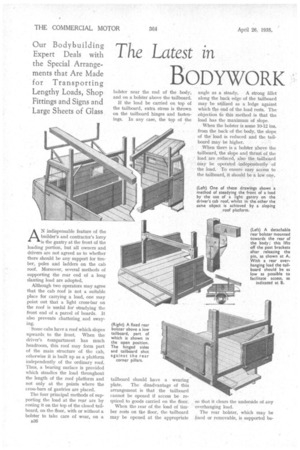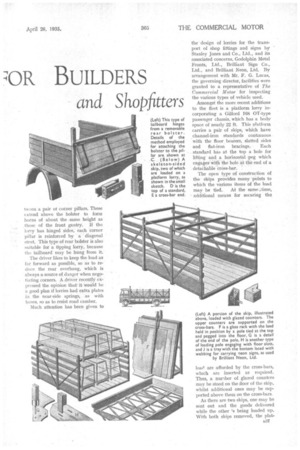The Latest in
Page 54

Page 55

Page 56

If you've noticed an error in this article please click here to report it so we can fix it.
BODYWORK OR BUILDERS
and Shopfitters
AN indispensable feature of the builder's and contractor's lorry is the gantry at the front of the loading portion, but all owners and drivers are not agreed as to whether there should be any support for timber, poles and ladders on the cab roof. Moreover, several methods of supporting the rear end of a long slanting load are adopted.
Although two operators may agree that the cab roof is not a suitable place for carrying a load, one may point out that a light cross-bar on the roof is useful foil steadying the front end of a parcel of boards. It also prevents chattering and swaying.
Some cabs have a roof which slopes upwards to the front. When the driver's compartment has much headroom, this roof may form part of the main structure of the cab, otherwise it is built up as a platform independently of the ordinary roof. Thus, a bearing surface is provided which steadies the load throughout the length of the roof platform and not only at the points where the cross-bars of gantries are placed.
The four principal methods of supporting the load at the rear are by resting it on the top of the closed tailboard, on the floor, with or without a bolster to take care of wear, on a
B36 bolster near the end of the body, and on a bolster above the tailboard.
If the load be carried on top of the tailboard, extra stress is thrown on the tailboard hinges and fastenings. In ally case, the top of the tailboard should have a wearing plate. The disadvantage of this arrangement is that the tailboard cannot be opened if access be required to goods carried on the floor.
When the rear of the load of timber rests on the floor, the tailboard may be opened at the appropriate angle as a steady. A strong fillet along the back edge of the tailboard may be utilized as a ledge against which the end of the load rests. The objection fo this method is that the load has the maximum of slope.
When the bolster is some 10-12 ins. from the back of the body, the slope of the load is reduced and the tailboard may be higher.
When then is a bolster above the tailboard, the slope and thrust of the load are reduced, also the tailboard may be operated independently of the load. To ensure easy access to the tailboard, it should be a low one,
tween a pair of corner pillars. These extend above the bolster to form horns of about the „same height as :those of the front gantry. If the lorry has hinged sides, each 'corner pillar is reinforced by a • diagonal strut. This type of rear bolster is also suitable for a tipping lorry, because the tailboard may be hung from it.
The driver likes to keep the load as far forward as possible, so as to reduce the rear overhang, which is always asource of danger when negotiating corners. A driver recently% expressed the opinion that it would be a good plan if lorries had extra plates in the near-side springs, as with buses, so as to resist road camber.
Much attention has been given to
the• design of lorries for the transport of shop fittings and signs by Stanley Jones and Co., Ltd., and its associated concerns, Godolphin Metal Fronts, Ltd., Brilliant Sign Co., Ltd., and Brilliant Neon, Ltd. By arrangement with Mr. F. G. Lucas, the governing director, facilities were granted to a representative of The• Commercial Motor for inspecting the various types of vehicle used.
Amongst the more recent additions to the fleet is a platform lorry incorporating a Gifford 168 OT-type passenger chassis, which has a body space of nearly 22 ft. This platform carries a pair of skips, which have channel-iron standards continuous with the floor bearers, slatted sides and flat-iron bracings. Each standard has at the top a hole for lifting and a horizontal peg which engager with the hole at the end of a detachable cross-bar.
The open type of construction of the skips provides many points to which the various items of the load may be tied. At the same ;time, additional means for securing tho load are afforded by the cross-bars, which are inserted as required. Thus, a number of glazed counters may be stood on the floor of the skip, whilst additional ones may be supported above them on the cross-bars.
As there are two skips, one may be sent out and the goods delivered while the other '43 being loaded up. With both skips removed, the plat form is then available for goods packed in large cases, such as frequently occurs with export orders. It may not be generally known that metal shop fronts ready for glazing are exported to such places as France, Algiers and Egypt. At the present time, Godolphin Metal Fronts, Ltd., has in hand an order for Caen, Normandy, which requires a case 50 ft. long.
Glass is carried on single and double-sided racks. Both types can be placed on the floor of any lorry. ale single rack is secured to the side of the vehicle and the bottom edge of the glass rests on felt pads. The sheets of glass are held against the rack by poles.
The bottom of the pole has a peg, which registers with a hole in the floor. There are sets of holes about if in, apart, so that the position of the pole may be adjusted.
The double-sided rack has its own base board with holes for the pins of the poles. The top of the pole is tied to the framework of the rack, or, if the sheets be large, to extensions of it. Poles are also used for securing other goods against the side of the lorry. These poles have a plate on one side which projects at one end, so that it may be inserted in a floor slot. The position of the pole may be varied not only by the choice of slot, but also according to whether the projecting foot is in front or behind the pole.
Neon signs are carried in a skeleton wood tray, which has at the bottom a latticework of webbing. The glass letters are secured to the webs with fine wire.




































































































